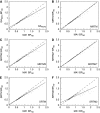Kinetic modeling of the serotonin 5-HT(1B) receptor radioligand [(11)C]P943 in humans
- PMID: 19773803
- PMCID: PMC2949107
- DOI: 10.1038/jcbfm.2009.195
Kinetic modeling of the serotonin 5-HT(1B) receptor radioligand [(11)C]P943 in humans
Abstract
[(11)C]P943 is a new radioligand recently developed to image and quantify serotonin 5-Hydroxytryptamine (5-HT(1B)) receptors with positron emission tomography (PET). The purpose of this study was to evaluate [(11)C]P943 for this application in humans, and to determine the most suitable quantification method. Positron emission tomography data and arterial input function measurements were acquired in a cohort of 32 human subjects. Using arterial input functions, compartmental modeling, the Logan graphical analysis, and the multilinear method MA1 were tested. Both the two tissue-compartment model and MA1 provided good fits of the PET data and reliable distribution volume estimates. Using the cerebellum as a reference region, BP(ND) binding potential estimates were computed. [(11)C]P943 BP(ND) estimates were significantly correlated with in vitro measurements of the density of 5-HT(1B) receptors, with highest values in the occipital cortex and pallidum. To evaluate noninvasive methods, two- and three-parameter graphical analyses, Simplified Reference Tissue Models (SRTM and SRTM2), and Multilinear Reference Tissue Models (MRTM and MRTM2) were tested. The MRTM2 model provided the best correlation with MA1 binding-potential estimates. Parametric images of the volume of distribution or binding potential of [(11)C]P943 could be computed using both MA1 and MRTM2. The results show that [(11)C]P943 provides quantitative measurements of 5-HT(1B) binding potential.
Figures





References
-
- Arulmozhi DK, Veeranjaneyulu A, Bodhankar SL. Migraine: current concepts and emerging therapies. Vascul Pharmacol. 2005;43:176–187. - PubMed
-
- Baker KG, Halliday GM, Törk I. Cytoarchitecture of the human dorsal raphe nucleus. J Comp Neurol. 1990;301:147–161. - PubMed
-
- Beck JV, Arnold KJ. Parameter Estimation in Engineering and Science. New York, NY: Wiley; 1977.
-
- Bevington PR, Robinson DK. Data Reduction and Error Analysis for the Physical Sciences. New York, NY: McGraw-Hill; 2003.
-
- Boschert U, Amara DA, Segu L, Hen R. The mouse 5-hydroxytryptamine1b receptor is localized predominantly on axon terminals. Neuroscience. 1994;58:167–182. - PubMed
Publication types
MeSH terms
Substances
Grants and funding
LinkOut - more resources
Full Text Sources
Medical

